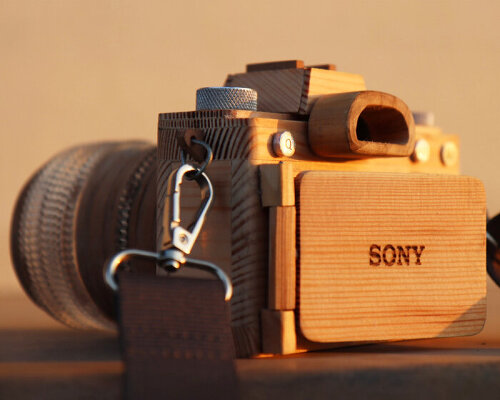Wooden Scale model of Sony Alpha 7R camera
Ridhima Saini shows what modern cameras such as the Sony Alpha 7R could look like if they were handcrafted from wood again. The student designer helps bring back the period when photographic devices used wood as their primary material, like the camera obscura. For this project, she crafts the wooden camera to match the Sony Alpha 7R’s real shape and size, guided by Mr. Trilok Chauhan, as her goal is to make the scale model look and feel like its real counterpart. While the main body and material are wood, she uses metal and acrylic for the details, with the latter being used around and in the part of the lens alongside medium-density fiberboard.
The Sony Alpha 7R wooden camera’s grip comprises 22 fiberboard pieces, each having the same size, so when they’re stacked together, they form a curve. There’s a movable dial inside the grip, and a three-millimeter aluminum rod works as the axis. The designer also uses a small diamond file to cut the grooves on the dial’s edge, giving it texture and making it easier to turn. The knobs are also made from aluminum rod, and for the screen that can rotate 180 degrees, the team cut three small cuboids, two of them longer to let the screen turn, and a steel rod is inserted into the holes to act as the hinge pin, allowing the screen cover to rotate all the way around the axis. Finally, the team sands every wooden part of the Sony Alpha 7R camera to smoothen its parts.
all images courtesy of Ridhima Saini
The Role of Wood in Early photography devices
In the past, the frames of camera obscuras were made of cardboard boxes and paper, with lenses made of plastic magnifying glasses. Controlling light was important in these devices because the light coming from outside could ruin the image, so wood was an ideal material because it was dark and blocked light well. The material was malleable, so it took on shapes easily, and it didn’t react with chemicals or give off odors, which were then useful features in traditional photography. Wood was able to keep the temperature and sound stable inside the camera too, as it is naturally ideal for vibration absorption, a handy helper during long camera exposures.
But wood was also heavy, as seen in the dubbed first daguerreotype camera, made by French art restorer Alphonse Giroux. It was a wooden box design with sliding parts weighing over 40 pounds, so it absorbed water from the air and could make it expand or shrink. This caused the wood to change shape, crack, or bend. As camera designs became more precise, it became a serious issue because small changes in shape could ruin the picture by misaligning the lens or film. Because of this, at least as one of the reasons, the cameras shifted from using wood to metal when the technology became more advanced.
Ridhima Saini shows what Sony Alpha 7R could look like if it were handcrafted from wood
Shifting to Metal in Camera Design
During the Industrial Revolution, machines were invented that could produce metal parts, and cameras began to use metal bodies, a material considered stronger and more stable than wood. When Austrian optician Peter Friedrich Voigtländer made a metal camera in 1841, it was a step forward and a shift because it consisted of metal instead of wood and featured the faster Petzval lens. By the late 1800s and early 1900s, metal cameras became more prevalent, and they were found to be easier to carry, last longer, and allow for more complex features. The camera body was more than just a container but a part of the system that produced high-quality images. It also helped that metal did not change shape with heat or moisture, and it could support better lens systems.
Photography improved over time, as better lenses needed more accurate camera parts. Wooden parts were not cut out for lighter, faster, and more convenient cameras, and so the manufactured, metal-looking photographic devices began spreading out. These days, however, shifting to metal from wood misses the touch of manual craftsmanship in exchange for faster production using machines. The distinctive care in crafting cameras is absent, as human hands were replaced by machines. But designers like Ridhima Saini are able to bring wooden cameras back, even if, at the moment, her Sony Alpha 7R is a scale model and not a functional one. It poses an example that, given the current technologies at hand, new cameras have a future of using natural materials that revive their distinctive character and traditional craftsmanship amidst automated production.
the knobs are machined from aluminum
the wooden screen can rotate 180 degrees
while the main body and material are wood, the design uses metal and acrylic for the details
view of the acrylic design around the lens
the wooden devices’s grip comprises 22 fiberboard pieces
project info:
model: Sony Alpha 7R
design: Ridhima Saini | @melon.at.work
The post what would new cameras such as sony alpha 7R look like if they were made of wood, again? appeared first on designboom | architecture & design magazine.

